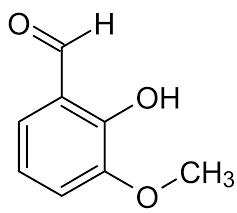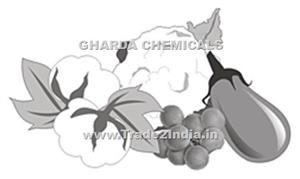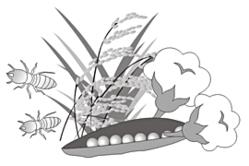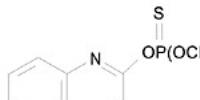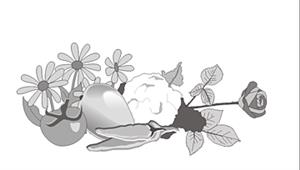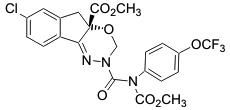GHARDA CHEMICALS LTD
Featured Products
Highest quality standards are achieved through the implementations of latest technology, decades of experience and everlasting moral values , which have helped us to retain our customers as well as multiply them.
Welcome to GHARDA CHEMICALS LTD
Anilofos
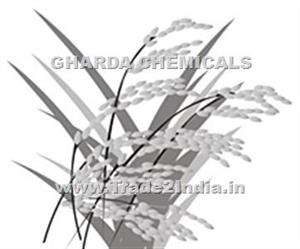
Description : ANILOFOS is a pre-emergence and early post-emergence selective herbicide used for control of annual grasses, sedges and some broad-leaved weeds in transplanted and direct seeded rice. Anilofos is absorbed by the weeds primarily through the roots and to some extent through newly emerging shoots and young leaves. Anilofos acts on meristematic tissues of weeds severely affecting cell division and cell elongation. Anilofos is being manufactured and marketed on a large scale for the first time in the world by Gharda, based on indigenous technology
Chemical Name: S-4-Chloro-N-isopropyl carbaniloylmethyl-O,O-dimethyl phosphorodithioate
Specifications :
The product conforms to IS : 13402 (1992)
a) Appearance : Yellowish brown semi solid or solid
b) Anilofos content by GLC : 93% (w/w) minimum
c) Moisture content by
Karl Fischer method : 0.5% (w/w) maximum
d) Acidity (as H2SO4) : 0.3% (w/w) maximum
e) Material insoluble in acetone : 0.5% (w/w) maximum
Formulations : Emulsifiable concentrate 18%, 30% (w/w), granules and dispersible powder 50% (w/w).
Compatibility : Compatible with 2,4-D formulations, Propanil and some other herbicides.
Toxicity :
a) Mammalian toxicity : WHO Classification : Class II "moderately hazardous". It is non-irritant to skin and mucous membrane.
b) Environmental toxicity : It is moderately toxic to birds. It has low toxicity to fish and bees.
Shelf-life : One year under normal storage conditions for TG & two years for EC.
Packing :
Technical Grade : 50 kg & 200 kg UN approved M.S. polylined drums
Formulation : Liquid : 50 Lit & 200 Lit UN approved M.S. Polylined / Lacqured Drums.
Clodinafoppropargyl

Description / Specification of Clodinafoppropargyl
We are involved in offering a wide range of Clodinafoppropargyl to our most valued clients. Our range of these are widely appreciated by our clients which are situated all round the nation. We offer our range of it at most affordable prices.
We introduce ourselves as an eminent trader and supplier of an extensive array of Clodinafoppropargyl. Prior to dispatch, our quality controllers run numerous tests on the entire range on various parameters of quality and durability. The offered equipment is manufactured using superior quality components with the aid of sophisticated techniques at the vendors' end. Moreover, our precious clients can purchase it in different technical specifications at reasonable price from us within promised time frame.
Features:
Sturdy design
Highly durable
Application specific design
Dicamba
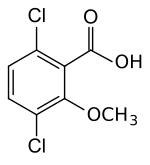
Description : DICAMBA is a selective systemic herbicide, absorbed through both roots and leaves. It translocates throughout the plant and acts as an auxin-like growth regulator. It is effective against annual and perennial broad-leaved weeds and brushed species in cereals, maize, sorghum, sugarcane, turf, pastures, range and non-crop areas. It can be used in combinations with many other herbicides.
Chemical Name : 3,6-dichloro-2-methoxybenzoic acid
Specifications :
a) Appearance : Colourless to pale buff flakes
b) Dicamba content : 97% (w/w) minimum
c) Melting Point : 112-116OC
d) Moisture content by : 0.5% (w/w) maximum
Karl Fischer method
e) Acetone insolubles : 0.5% (w/w) maximum
Formulations : Aqueous solution as dimethyl amine salt (480 g/l) - - CAS Registry No [2300-66-5].
We also offer
Dicamba potassium salt 97% min CAS Registry No. [10007-85-9]
Dicamba Sodium Salt 97% min CAS Registry No. [1982-69-0]
Compatibility : Compatible with most other herbicides.
Toxicity :
a) Mammalian toxicity : WHO classification : Class III, ‘slightly hazardous’. It is non-irritant to skin but irritant to eyes.
b) Environmental toxicity : It shows low toxicity to birds and fish. It is practically non-toxic to bees.
Shelf-life : Two years under normal storage conditions.
Packing :
Technical Grade : 45 kg flaked material / 70kg fused material in fibre Board Drums with LDPE liner, Also 500 kg antistatic jumbo bag.
"GCL holds EPA approval for sale of Dicamba Technical in the USA in 500 kg antistatic Jumbo bag. Formulation is sold under Compass label.
Isoproturon

Description : ISOPROTURON is a selective herbicide belonging to the family of substituted ureas and acts principally after root absorption, either pre-emergence or post emergence. It is effective against several broad-leaved weeds and numerous grassy weeds. It is safe to all varieties of soft winter wheat, barley and rye.
Gharda Chemicals Limited for the first time developed a commercial process for manufacture of Isoproturon Technical in India using the urea route. Now GCL is the second largest manufacturer of Isoproturon in the world. Gharda’s Isoproturon is exported to many European markets.
Chemical Name : 3-(4-Isopropylphenyl)-1,1-dimethylurea
Specification :
The product conforms to IS : 12004 (1987) and its amendments
a) Appearance : White to greyish white or yellowish crystalline powder
b) Isoproturon content by HPLC : 95% (w/w) minimum
c) Melting Point : 154OC minimum
d) Moisture content by
Karl Fischer method : 0.5% (w/w) maximum
e) i. Acidity (as H2SO4) : 0.1% (w/w) maximum
ii. Alkalinity (as NaOH) : 0.4% (w/w) maximum
Formulations : 50% WP (w/w), 75% WP (w/w), 500 SC (w/v), 75% WDG (w/w) and 83% WDG (w/w).
Compatibility : Compatible with 2,4-D, Cyanazine, Pendimethalin, Trifluralin and many other herbicides.
Toxicity :
a) Mammalian toxicity : "Slightly Hazardous".
b) Environmental toxicity : It shows low toxicity to fish, birds and bees.
Shelf-life : Two years under normal storage conditions.
Packing :
Technical Grade : 650 kg Antistatic Jumbo Bags and 25 kg UN approved Multiwall Paper Sacks or HDPE Woven sacks with LDPE liner.
Formulation : Solid : 20 kg UN approved Multiwall paper sacks with LDPE liner & 25 kg UN approved HDPE woven sacks with LDPE liner material.
Metamitron
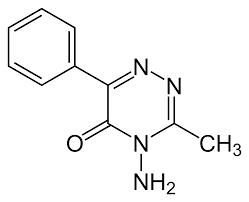
Description : METAMITRON is a selective systemic herbicide absorbed through both roots and leaves and is translocated to the chloroplast and inhibits photosynthesis. It is effective against grasses and broad-leaved weeds in sugar and fodder beet. Can be applied both as pre and post emergence.
Chemical Name : 4-amino-3 methyl-6 phenyl-1, 2, 4-triazin-5 (4H)-one
Specifications :
a) Appearance : White to light yellow amorphous power.
b) Metamitron content : 98% (w/w) minimum
c) Moisture content by
Karl Fischer method : 0.5% (w/w) maximum
d) Acidity (as H2SO4) : 0.1% (w/w) maximum OR Alkalinity (as NaOH) : 0.05% (w/w) maximum
Formulations : 700 WDG and 700 SC.
Compatibility : Compatible with other beet herbicides.
Toxicity :
a) Mammalian toxicity : WHO classification : Class II "moderately hazardous".
It is non-irritant to skin and mucous membrane.
b) Environmental toxicity : It shows low toxicity to birds and fish. It is non-toxic to bees.
Shelf-life : Two years under normal storage conditions.
Technical Grade : 25 kg UN approved multiwall paper sacks with LDPE liner and 25 kg / 40 kg UN approved Fibre Board Drums with LDPE liner.
Napropamide
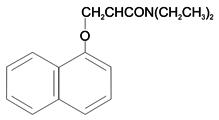
Description : NAPROPAMIDE is an aryloxyalkanamide herbicide for selective pre-emergence control of germinating weeds. Napropamide hits weeds at the very heart of the germination process by stopping cell division and root growth. Napropamide can be used in a wide variety of fruit and vegetables, field crops, flowers and ornamentals to control most annual grass weeds and a useful range of broad leaf weeds.
Chemical Name : N,N-diethyl-2-(1-napthyloxy) propionamide
Specifications :
a) Appearance : Off white brown powder
b) Napropamide content : 97% (w/w) minimum
Formulation : 450 SC
Compatibility : Compatible with many other herbicides and fungicides.
Toxicity :
a) Mammalian toxicity : WHO classification : “Product unlikely to present acute hazard in normal use.”
b) Environmental toxicity : Napropamide is non toxic to bees. It shows slight toxicity to fish and birds.
Shelf-life : Two years under normal storage conditions.
Packing :
Technical Grade : 50 kg UN specified Fibre Board Drums.
Sulfosulfuron
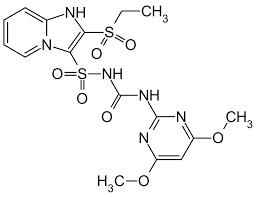
Description : SULFOSULFURON is a selective, systemic sulfonyl urea herbicide, absorbed through both roots and leaves. It translocates throughout the plant and acts as an inhibitor of amino acid biosynthesis, hence stopping cell division and plant growth. It is effective against grasses and broad-leaved weeds in wheat. Barley and oats are sensitive.
Chemical Name : N-[[(4,6-dimethoxy-2-pyrimidinyl) amino] carbonyl]-2- (ethylsulfonyl) imidazo [1,2-a] pyridine-3-sulfonamide
Specifications :
a) Appearance : Off-white odourless amorphous powder
b) Sulfosulfuron content by HPLC : 98% (w/w) minimum
c) Moisture Content by Karl : 0.20% (w/w) maximum
Fischer method
d) Melting Point : 201 – 203OC
Formulations : Water dispersible granules 75% w/w.
Compatibility : Not compatible with fertilizer solutions with pH < 5, nor with non-ionic surfactants or other additives that alter the pH of the spray solution below 5.
Toxicity :
a) Mammalian toxicity : EPA classification (formulation) : Class III. It is moderately irritant to skin and non-irritant to eyes.
b) Environmental toxicity : It is slightly toxic to birds and fish and non-toxic to bees.
Shelf-life : Two years under normal storage conditions.
Packing :
Technical Grade : 25kg, 50 kg, 100 kg, 200 kg UN approved Fibre Board drums with HDPE liner.
Formulation : 25 kg UN approved G. I. Drums.
Triclopyr Butoxy Ethyl Ester

Description : TRICLOPYR BUTOXY ETHYL ESTER is a butyl cellosolve ester of triclopyr, selective systemic herbicide which is rapidly absorbed through the roots and foliage. It translocates throughout the plant, accumulating in meristematic tissues and inducing auxin type responses. It is used for the control of woody plants and broadleaf weeds in grassland, uncultivated land, industrial areas, plantation crops and rice fields.
Chemical name (IUPAC): 2-butoxyethyl 3,5,6- trichloro-2-pyridyloxyacetate
Specifications :
a) Appearance : Brownish yellow viscous liquid
b) Triclopyr butoxy ethyl ester content : 97 % (w/w) minimum
c) Moisture content by Karl Fischer : 0.5 % (w/w) maximum
Method
d) Solvent Content by GLC : 0.5 % (w/w) maximum
Formulations : Emulsifiable concentrates as 25% , 32% and 60% EC
Compatibility : Compatible with most other herbicides
Toxicity :
a) Mammalian toxicity : “ Slightly hazardous”
b) Environmental toxicity : It shows low toxicity to birds and moderately toxic to fish.
It is non-toxic to bees.
Shelf life : Two years under normal storage conditions.
Packing : 50 kg UN specified lacquered MS drums
Plant Growth Regulators

Description / Specification of Plant Growth Regulators
We are involved in offering a wide range of Plant Growth Regulators to our most valued clients. Our range of these are widely appreciated by our clients which are situated all round the nation. We offer our range of it at most affordable prices.
We introduce ourselves as an eminent trader and supplier of an extensive array of Plant Growth Regulators. Prior to dispatch, our quality controllers run numerous tests on the entire range on various parameters of quality and durability. The offered equipment is manufactured using superior quality components with the aid of sophisticated techniques at the vendors' end. Moreover, our precious clients can purchase it in different technical specifications at reasonable price from us within promised time frame.
Features:
Sturdy design
Highly durable
Application specific design
Mepiquat Chloride
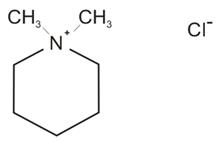
Description : MEPIQUAT CHLORIDE is absorbed by the plant primarily through leaves and translocated throughout the plant. It inhibits the biosynthesis of gibberellic acid, and leads to a deeper green leaf colouring after 3-6 days. It is used on cotton to reduce vegetative growth and to advance maturation of the bolls. It is also used in combination with ethephon to prevent lodging in cereal and flax.
Chemical Name : 1,1-dimethylpiperidinium chloride
Specifications (50% w/w aqueous solution) :
a) Appearance : Colourless or light yellow brown liquid
b) Assay (as Mepiquat chloride : 50% (w/w) minimum by gravimetry)
Formulations : Aqueous solution 5% (w/w)
Compatibility : Compatible with pyrethroids and organophosphate group of insecticides and fungicide carbendazim.
Toxicity :
a) Mammalian toxicity : WHO classification : Class III "slightly hazardous". It is non-irritant to skin and eyes. Not a skin sensitizer.
b) Environmental toxicity : It shows low toxicity to birds and fish. It is non-toxic to bees.
Shelf-life : Two years under normal storage conditions.
Packing : 50 kg, 100 kg, 200 kg UN specified polylined MS drums / HDPE containers
Our Vision
* To embrace new technologies and methods. * To give unsurpassed products and services to the clients. * To constantly look for improvement and changes.



